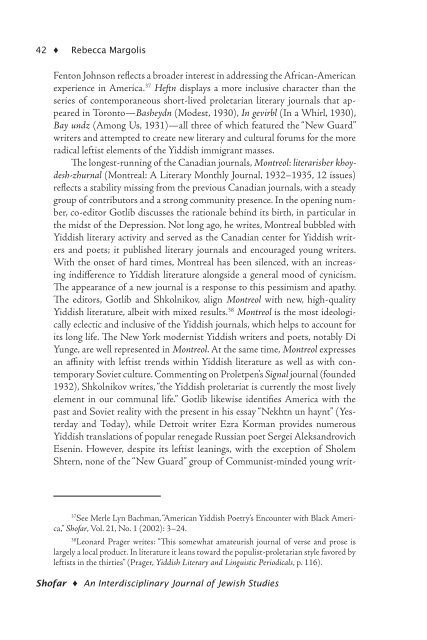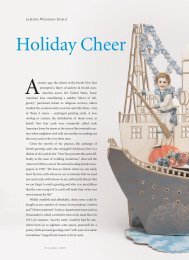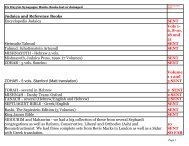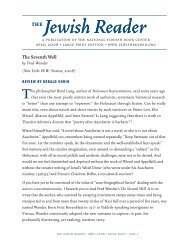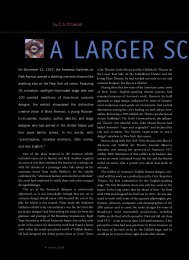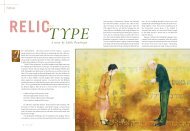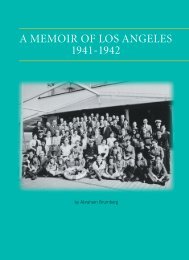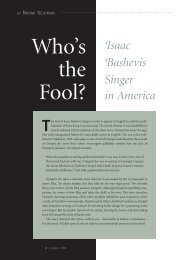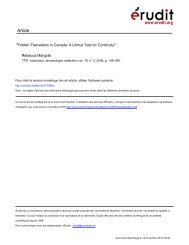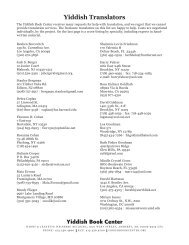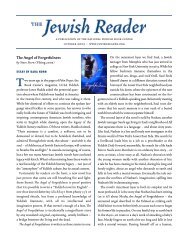Negotiating Jewish Canadian Identity Montreal Yiddish Literary ...
Negotiating Jewish Canadian Identity Montreal Yiddish Literary ...
Negotiating Jewish Canadian Identity Montreal Yiddish Literary ...
Create successful ePaper yourself
Turn your PDF publications into a flip-book with our unique Google optimized e-Paper software.
42 ♦ Rebecca MargolisFenton Johnson reflects a broader interest in addressing the African-Americanexperience in America. 37 Heftn displays a more inclusive character than theseries of contemporaneous short-lived proletarian literary journals that appearedin Toronto—Basheydn (Modest, 1930), In gevirbl (In a Whirl, 1930),Bay undz (Among Us, 1931)—all three of which featured the “New Guard”writers and attempted to create new literary and cultural forums for the moreradical leftist elements of the <strong>Yiddish</strong> immigrant masses.The longest-running of the <strong>Canadian</strong> journals, Montreol: literarisher khoydesh-zhurnal(<strong>Montreal</strong>: A <strong>Literary</strong> Monthly Journal, 1932–1935, 12 issues)reflects a stability missing from the previous <strong>Canadian</strong> journals, with a steadygroup of contributors and a strong community presence. In the opening number,co-editor Gotlib discusses the rationale behind its birth, in particular inthe midst of the Depression. Not long ago, he writes, <strong>Montreal</strong> bubbled with<strong>Yiddish</strong> literary activity and served as the <strong>Canadian</strong> center for <strong>Yiddish</strong> writersand poets; it published literary journals and encouraged young writers.With the onset of hard times, <strong>Montreal</strong> has been silenced, with an increasingindifference to <strong>Yiddish</strong> literature alongside a general mood of cynicism.The appearance of a new journal is a response to this pessimism and apathy.The editors, Gotlib and Shkolnikov, align Montreol with new, high-quality<strong>Yiddish</strong> literature, albeit with mixed results. 38 Montreol is the most ideologicallyeclectic and inclusive of the <strong>Yiddish</strong> journals, which helps to account forits long life. The New York modernist <strong>Yiddish</strong> writers and poets, notably DiYunge, are well represented in Montreol. At the same time, Montreol expressesan affinity with leftist trends within <strong>Yiddish</strong> literature as well as with contemporarySoviet culture. Commenting on Proletpen’s Signal journal (founded1932), Shkolnikov writes, “the <strong>Yiddish</strong> proletariat is currently the most livelyelement in our communal life.” Gotlib likewise identifies America with thepast and Soviet reality with the present in his essay “Nekhtn un haynt” (Yesterdayand Today), while Detroit writer Ezra Korman provides numerous<strong>Yiddish</strong> translations of popular renegade Russian poet Sergei AleksandrovichEsenin. However, despite its leftist leanings, with the exception of SholemShtern, none of the “New Guard” group of Communist-minded young writ-37See Merle Lyn Bachman, “American <strong>Yiddish</strong> Poetry’s Encounter with Black America,”Shofar, Vol. 21, No. 1 (2002): 3–24.38Leonard Prager writes: “This somewhat amateurish journal of verse and prose islargely a local product. In literature it leans toward the populist-proletarian style favored byleftists in the thirties” (Prager, <strong>Yiddish</strong> <strong>Literary</strong> and Linguistic Periodicals, p. 116).Shofar ♦ An Interdisciplinary Journal of <strong>Jewish</strong> Studies


